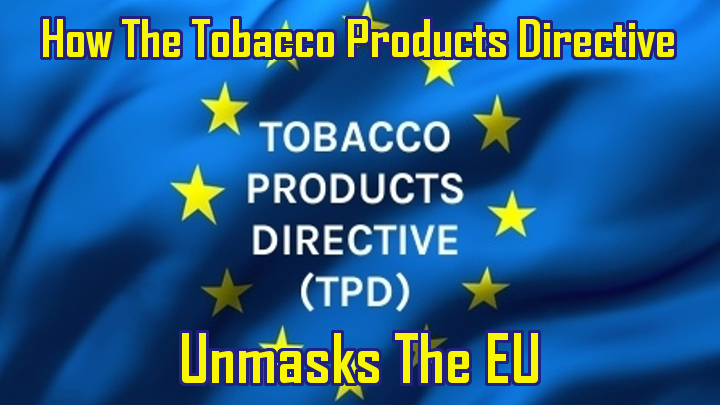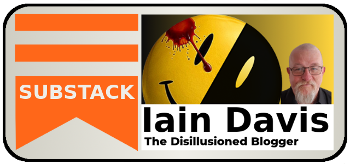The updated Tobacco Products Directive (TPD2) is, on the face of it, a perfectly sensible piece of EU legislation which seeks to further regulate the tobacco industry to protect public health.
Despite the fact that the EU has no mandate to regulate on health, few could justifiably argue that tobacco doesn’t need tight regulation. It certainly has a terrible impact upon the health outcomes of millions.
Recent figures have suggested that globally, an estimated 500 million people will die from smoking related illness in the next decade.
So the TPD, driven by perfectly sensible concerns for wider public health, is surely a good thing?
Am I therefore suggesting that this directive demonstrates the benign and essentially progressive nature of the EU?
No. The opposite actually.

What it reveals is the undemocratic nature of a heavy handed legislature, which is designed to impose the will of big business over and above any other concern. Including the deaths of millions of its own citizens.
A Corporate Market Attack to Gain Control
Contained within the TPD is Article 20 which proposes legislation to control the emerging market for electronic cigarettes.
The history of how this legislation emerged exposes the oppressive forces at the heart of the EU project. It shows how, ultimately, the EU is a control system. One designed to maintain massive corporate profits by creating barriers to market competition, for the benefit the established hegemony.
Firstly I need to disclose my own confirmation bias. As someone who smoked at least 50mg of tobacco a week for more than 30years the switch to vaping, which I made 3 years ago, has massively improved my health. I can breathe more easily, have a carbon monoxide reading of a non-smoker and no longer suffer from perpetual chest infections. In short my health outcomes have almost certainly improved.
 I fully accept that the rapid, recent emergence of vaping products means that I, along with millions of others, do not know exactly what the long term health impact of my vaping habit will be. What I do know is that the impact on my health today has been marked and that all available independent studies show that my vaping habit is 95% safer for me than smoking.
I fully accept that the rapid, recent emergence of vaping products means that I, along with millions of others, do not know exactly what the long term health impact of my vaping habit will be. What I do know is that the impact on my health today has been marked and that all available independent studies show that my vaping habit is 95% safer for me than smoking.
Secondly I am not against the creation of a set of manufacturing regulations for these products. It makes perfect sense to me that legislation should be enacted that ensures safety standards are both well-defined and enforced.
So, in part, I support the TPD.
However, within Article 20 of TPD2, a rather dark and unpleasant hand can clearly be seen at work. One, I suggest, that points to the true nature of the EU.
As ever, to find evidence of this manipulation we need to heed ‘Deep Throat’s’ advice and “follow the money.”
Both the Tobacco and the pharmaceutical corporations are worried about vaping. And with good reason, with some analysts predicting that vaping sales could outstrip total cigarette sales as early as 2024.
In 2012 the global market for nicotine replacement therapy products (NRT) was an estimated $5.1 Billion. With the rapid rise in the number of smokers choosing to quit, this market was projected to grow to more than $16 billion by 2019.
Worldwide tobacco sales in 2014 were valued at $744 billion. Vast profits are being maintained because, whilst consumption is dropping in high income countries (such as those in Western Europe) it is increasing in low-middle income countries (especially in Asia and Africa.) This is due to far less regulation in these emerging markets.
Whilst the impact of vaping on global tobacco profits has been negligible the increasingly stringent controls on tobacco products in Europe has prompted the big tobacco companies to enter the vaping market with a clear sense of urgency. Since 2013 they have made a series of acquisitions of some of the new vaping brands. A look at the timeline of these acquisitions clearly illustrates their intention to aggressively break into the vaping market.

But the large, slow moving tobacco giants have failed to recognise the rapid development of the vaping market. The manufacturers they have bought out have largely been producing 1st generation vapes that look like cigarettes.
All the innovation however has been away from that model towards 3rd generation vapes (that look nothing like cigarettes.) These now dominate the vape market and the big tobacco corporations have failed to innovate. It remains the smaller, independent companies who are currently the vape market leaders. Their buy out strategy has largely failed, in other words.
Corporate Anti Health Strategy
However the emergence of vaping has hit the NRT market much harder. Impacting heavily upon the European profits of the big pharmaceutical companies (often referred to as ‘Big Pharma’)
In 2015 the global vaping market exceeded $6 Billion. This has impacted massively upon sales of NRT. For example, 2012 saw the volume of e-cig sales outstrip those of NRT. Recent years have seen a continuing reduction of market share for the manufacturers of NRT products.
Companies like Glaxo Smith Kline (GSK), Johnson&Johnson and Novartis have seen a significant reduction in sales of NRT as a result.
So, from a health perspective, has this transition away from NRT to vaping improved health outcomes for smokers?
This is where, admittedly, the figures get a little hazy. As I said, the long term health outcomes for those switching to vaping cannot yet be proven. However, if we accept that vaping is indeed 95% safer than smoking, what do the figures suggest?
Well studies show that that an estimated 30% of the EU population currently smoke. This causes 700,000 premature deaths in the EU every year.
Further studies show that in the UK alone 2.2 million people vape. Of these 10% have quit smoking every year as a result. The University college London (UCL) estimate that this resulted in an extra 22,000 people quitting smoking in 2014, in the UK alone. They also estimate that, compared to NRT, e-cigs appear to be 50% more effective in terms of supporting people to quit.
Furthermore the increasing use of e-cigs has also apparently lead to an increase in quit rates overall. Although other anti-smoking measures, such as public smoking bans, have also clearly had an impact.
An oft quoted objection to vaping is that it is somehow a “gateway” to smoking. The anti vaping lobby (much more on them shortly) have cited a number of predominantly U.S led studies which claim to show an increasing uptake amongst young people.
What none of these studies explain is whether those young people would have taken up smoking instead. Nor do they account for the fact that smoking rates (not vaping rates) amongst the under 25’s remains stubbornly consistent.
The Royal College of Physicians can find little or no evidence to support the U.S studies. Rather they suggest that the evidence is overwhelming that vaping take up is almost exclusively amongst those who already smoke. Indicating that, far from being a gateway into smoking, vaping is actually a very effective doorway out.
Professor John Britton, chair of the Royal College of Physicians Tobacco Advisory Group, speaking about their study, said, “This report lays to rest almost all of the concerns over these products and concludes that, with sensible regulation, electronic cigarettes have the potential to make a major contribution towards preventing…premature death.”
Doctors have also stressed the importance of regulations do not “significantly [inhibit] the development and use of harm-reduction products by smokers.”
There is an overwhelming body of evidence that vaping is likely to avert hundreds of thousands of premature deaths within the EU every year. It can literally be seen as a life saver.
In fact the former UK drugs policy advisor, and widely respected independent scientific researcher, Professor David Nutt stated that vaping is “the greatest health advance since vaccinations.”
SME’s Thriving? That Will Never Do.
 Not only has vaping produced massive health benefits it has also seen an explosion of innovation, new start-up businesses and employment opportunities across the EU. In the UK alone there are now an estimated 8000 vaping outlets. There are new product manufacturers, growing distribution networks, vapers café’s, service industries and an ever increasing number of jobs linked to this emerging market.
Not only has vaping produced massive health benefits it has also seen an explosion of innovation, new start-up businesses and employment opportunities across the EU. In the UK alone there are now an estimated 8000 vaping outlets. There are new product manufacturers, growing distribution networks, vapers café’s, service industries and an ever increasing number of jobs linked to this emerging market.
Many of these businesses (though growing rapidly) are smaller to medium size enterprises (SME’s,) employing local people in their local communities. New entrepreneurs are creating wealth across the continent.
And yet the EU has decided, not only to stifle all of this energy and innovation, but also to legislate against the health interests of its own citizens. What the TPD2 effectively achieves is to promote smoking.
Prof Peter Hajek, Director of the Tobacco Dependence Research Unit at Queen Mary University of London, said:
“The new EU regulation of e-cigarettes is seriously misguided. It is hostile to e-cigarettes and puts bigger hurdles on vaping that on smoking.
“It stipulates limits on nicotine concentrations than do not apply to cigarettes, requires expensive, obscure and onerous product notifications that are not needed for cigarettes, enforces unnecessary product rules that will make vaping less user friendly and more expensive, puts enforced delays on approving new products, enforces excessive warnings including warning leaflets that are not needed for cigarettes, and includes other restrictions that favour the incumbent product.
“. . . . . . . . it will slow down the desertion from smoking to much less risky vaping. Tobacco industry executives will be pleased, but this is not good news for public health.”
Why on Earth would an institution, supposedly set up to improve the lives of its citizens, do something which threatens their employment and their health? Why would the EU pass a Tobacco Products Directive which, by restricting access to the most effective smoking alternative, is effectively pro-smoking.
Sadly, it is the telling of the ‘why’ which reveals what the EU is really all about.
The True Corporate Face of the EU
When we look at the so called evidence which has led to Article 20 of the TPD, what we see is a network of funding streams from the big pharmaceutical corporations (Big Pharma) and the tobacco lobby into the influential Non-Governmental Organisations (NGO’s), supposedly independent health bodies and statutory organisations who have provided the vast bulk of the data analysis.
For instance the World Self Medication Industry (WSMI), an NGO which states its official links to the World Health Organisation, stated in a 2012 report “manufacturers and distributors mislead people into believing these devices are acceptable alternatives to scientifically proven cessation techniques.”
However the WSMI also states “WSMI members are world leaders in the manufacture and supply of Nicotine Replacement Therapy (NRT) products.”
There is little or no acknowledgment of this conflict of interest in any of the reports used to vilify vaping.
Action on Smoking and Health (ASH international) infamously said that any scientist who defends e-cigarettes is being funded by the e-cig manufacturers. They are entitled to their opinion. However they have received millions of dollars in funding from Pfizer the company that manufactures smoking cessation drugs. ASH international makes no mention of this fact on their accounts.
Similarly charitable organisations, such as the Robert Wood Johnson foundation (from Johnson&Johnson,) have long funded leading opponents of vaping such as the American Cancer Society and American Heart Association.
A prominent voice against vaping has come from Professor Stanton Glantz of the University of California at San Francisco. While working for the ‘Center For Tobacco Control and Education,’ Professor Glantz produced some meta-analysis which suggested that quit rates amongst those who vaped was substantially lower than for smokers who chose to use NRT.
So skewed was his analysis that it prompted the Lancet (Respiratory Medicine) journal to issue the statement that his research made “no scientific sense.”
[sociallocker id=”2281″]
[/sociallocker]
Professor Glantz and ‘the Center For Tobacco Control and Education’ are largely funded by the American Heart Association.
Johnson&Johnson and Glaxo Smith Kline in other words.
However if some of the funding for these NGO’s and prominent researchers seems slightly suspicious, the influence of the big corporations on governmental institutions is even more pronounced.
For example, the Medicines and Healthcare Products Regulatory Agency (MHRA), which is part of the UK department of health, is tasked with ensuring the safety of medical devices and medicines. The MHRA, and its U.S counterpart the Food and Drugs Administration (FDA), have been instrumental in the consultations underpinning the TPD.
As far back as 2010 the MHRA sought to change the way nicotine containing products were classified. No one, to that date, had claimed that e-cigarettes were a smoking cessation products. Rather they were marketed as an alternative to smoking.
However the MHRA sought to class vaping products as a “smoking cessation” product. In doing so they would force vaping manufacturers to fall under their (and in the U.S the FDA’s) regulatory authority. This would place an onus upon the vaping industry to meet the stringent testing and medical device application costs required to register their products as “medicine.”
In one foul swoop this would effectively price many of the new, innovative manufacturers out of the market. Only those with the very deepest pockets would be able to meet these massive legal costs. Namely the big pharmaceutical and tobacco companies.
The MHRA receives funding for the licensing of medical devices from the UK tax payer. However it’s funding for licensing medicines comes directly from the pharmaceutical industry. The same corporations that are heavily invested in the multi-billion dollar NRT market.
When considering these funding implications the House of Commons Select Committee looking into the pharmaceutical industry stated that the MHRA was so closely linked to the large corporations that they had “common policy objectives, agreed processes, frequent contact, consultation and interchange of staff.”
Perhaps this fact may explain why, amongst the hundreds if not thousands of vaping products available on the current market, the only ones that have been approved by the MHRA, such as the e-Voke and the Puritane, just happen to be manufactured by Nicovations Limited, part of British American Tobacco’s Next Generation Products division and Fontern Ventures, a wholly owned subsidiary of Imperial Tobacco.
This powerful link between the anti-vaping lobby and the corporations was further exposed by a 2014 FOI request which revealed emails between Sophie Crousse, the Brussels-based vice president of European public affairs for GSK’s consumer health-care division, and Dominik Schnichels, of SANCO (the European Commission’s Directorate General for Health & Consumers.)
Despite a welter of serious scientific evidence to the contrary, Crousse advises Schnichels that “allowing e-cigarettes to be marketed as tobacco/consumer products without any health claims would potentially open a gateway to nicotine addiction and encourage wider nicotine usage.” Furthermore GSK have openly admitted their numerous meetings with “certain members” of the European Commission prior to the conclusion of the TPD2 consultation.
The Corporate EU In Action
So then we arrive at the EU public consultation report for the TPD2 itself.
This report acknowledges contributions from Government and public Authorities (such as the MHRA) industry (such as GSK and Johnson&Johnson,) NGO’s (such as the WSMI) and finally submissions from the public. It states that consideration was given to more than 85,000 submissions in total.
You may feel that submissions from the public at least meant that the individual vapers voice was heard. Unfortunately, because many vapers added their voices to online petitions, the EU commission simply dismissed more than 59% of them as being “duplicates.”
So what we have ended up with is an EU directive which has been overwhelmingly driven by dubious scientific research and the vested interests of global corporations.
The aim of this legislation is clear.
Firstly it will ensure smaller producers cannot compete, as they are unlikely to be able to meet licensing costs. This will open up the vape market to the tobacco giants and exclude most, if not all, of the current SME market leaders.
TPD2, by limiting the size of fluid reservoirs (tanks), specifying thinner & sealed refill cartridges and other measures, clearly discriminates against the 3rd generation vapes in favour of the cigarette like alternative. In other words, it discriminates against the smaller, innovative manufacturers to the benefit of, you guessed it, the big corporations.
Secondly it means that the NRT market is protected for the big corporations. This allows them to continue to sell products which have been proven to be less effective at helping people to quit smoking. Free market principles have been abandoned. Not least of all for the fact that the free market doesn’t actually exist in a global economy dominated by global corporations. Especially if they can simply demand compliant political bodies, like the EU, do their bidding.
Are you starting to see a pattern here?
Also, by categorising vaping products as “tobacco”, despite the fact that they are not at all, governments will be able to levy punitive taxes against them (as they rightly do on real tobacco products) thereby vastly increasing the price to consumers and further discouraging their use.
Many small to medium size businesses will probably fold as a result. Thousands of EU citizens will lose their jobs and more smokers will die.
The global corporations will make more money because the EU has legislated to assist their takeover of the market.
The EU court of justice (ECJ) did kindly permit one legal challenge from the vape company Totally Wicked but summarily dismissed it with no right of appeal.
For some reason, one can only speculate why, the unelected EU Commission has rejected the vast body of independent scientific research proving the benefits of vaping in favour of some entirely financed by the people who stand to commercially gain from the legislation the EU has obsequiously trotted out on their behalf.
This has now been ratified by the European Council. More people will die.
Unfortunately, there’s nothing you can do about it because nobody elected them to their Council seats either.
So who do you think the EU serves?









Be the first to comment on "How The Tobacco Products Directive (TPD) Unmasks The EU."